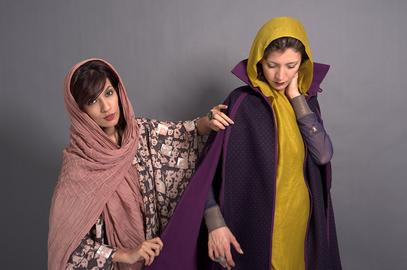In November, authorities in Qazvin province in northwest Iran closed down several modeling agencies, and arrested dozens of people working in fashion. It was the latest in a serious of attacks on the industry, which began with the arrests of seven models in January. In March, Iran’s cyberspace unit launched Operation Spider 2, blocking the Instagram pages of those models previously arrested, as well as others.
The arrests and attacks were part of a larger initiative to crack down on people “promoting a culture of promiscuity, weakening and rejecting the institution of family, and ridiculing religious values and beliefs,” among other charges.
But what’s fashion really like in Iran? Is it always about the enforced hijab and people being asked to observe Islamic ideals of modesty? If people ignore the rules, how much trouble do they really encounter?
Iranians Wore Swimsuits, Mini-Skirts and Hippy Fashion
Before the Islamic Revolution in 1979, Iranians — men and women alike — were allowed to wear just about anything they wanted. Western media is fond of pointing to photographs of women in fashionable 1970s garb, including mini-skirts and fashionable floral designs of the time. Big stars like Googoosh helped set the latest in fashion trends.
Not everyone went with the latest trends, of course. Regional and religious traditions also determined what women wore (and still do). For example, women’s traditional dress in the southeastern province of Kerman is characterized by full skirts in bright-colored patterns, and Iranians of Turkmen descent living in the north and northeastern area of Iran have a tradition of embroidered fabric, silk, silver and fur-lined large “telpek” hats for men.
But, soon after the revolution, everything changed, as the new leaders of the country, led by Ayatollah Khomeini, introduced new Islamic rules and laws. Women in Iran, irrespective of their beliefs or religions, had to abide by an Islamic dress code that meant they had to cover their hair and body in public. In many Islamic countries, girls must cover up when they reach puberty, but in Iran, they are regularly instructed to wear the hijab when they begin school — so at age six or seven years old.
Defying the Rules can be a Fashion Statement
“For the first few years following the decree, Iranian women publicly staged their objection to and resistance against the new law,” says human rights lawyer and author Mehrangiz Kar. “They organized protests and used other peaceful means to reject this form of repression.” But, she says, the extent to which the new law was institutionalized meant that, “ultimately, Iranian women had to submit to this state-sponsored form of discrimination.” If they refused to follow the new rules, they had to face the consequences, which might mean being arrested and spending a night in custody.
Despite this, women and men have continued to put themselves at risk by defying the dress codes, and ultimately making it impossible for the state to control people to the extent it would like.
Mojdeh, an Iranian women who was born a few years before the revolution, talked to IranWire about what it was like to go to school in Iran in the 1980s. “We had to wear dark navy manteaux [a long coat or heavy button-up blouse] with loose pants. We were not allowed to wear tight pants. We also had to wear only black or white socks — not any other colors.” Some women wore the chador, which not only covers the head, but the whole body, leaving only the face visible.
For Iranian women, wearing colorful clothes was out of the question for several years. But a lot of women were unhappy about the restrictions, and vowed to do something about it and reinstate their freedom to dress how they wanted. And then, in 1997, Mohammad Khatami, a reformist, was elected as president of Iran. During his government, Iranian society changed gradually, and with it, attitudes and approaches to style and dress changed too.
“You couldn’t see many colors in the streets when I was younger, but nowadays you see people wear different colors," says Negin, a 42-year-old Iranian designer working in Iran today. Even veils are stylish and some of them are well designed.” But she says women still need to be careful. “Of course, some colors, like orange or bright red, are still not very common in Iran, but seeing various colors is better than seeing only black or gray.” Brands like Coocooz sell fashionable, inventive manteuux in modern cuts and fabrics.
In 2014, well-known Iranian journalist Masih Alinejad launched My Stealthy Freedom, an online movement where women share photographs of themselves not wearing the hijab. The campaign started on Facebook after Alinejad posted photos of herself and encouraged other women to do the same. The campaign received widespread media attention and the website archives videos, photographs and statements from women around the world.
Men also face restrictions. They are banned from wearing sleeveless shirts or shorts, and, in 2015, Iranian authorities cracked down on “un-Islamic haircuts,” as well as on tattoos. This followed a 2010 ban on “Western” hairstyles including mullets, spikey hair, and ponytails. Authorities also released a list of “approved” haircuts for men.
Modeling is a Risky Business
Like artists, musicians, writers, and filmmakers, Iran’s models can easily find themselves in trouble in Iran, especially if they try to push the boundaries of what’s allowed. In January, Revolutionary Guards, still preoccupied with an “anti-infiltration” operation they launched in late December 2015 that resulted in the arrest of four journalists, turned their attention to fashion. They arrested seven models, accusing them of “moral corruption.” Weeks later, authorities launched Operation Spider 2, targeting models’ Instagram pages and blocking content and photographs. Some of those arrested had posted photographs of themselves not wearing hijab, though several of them had observed the Islamic guidelines on dress. Months later, in November, came the crackdown in Qazvin, which saw the arrests of models and other people who work in the industry.
Behind Closed Doors, the Latest Fashion
But just because women in the Islamic Republic did not appear fashionable in public in the 1980s and into the 1990s, that doesn’t mean they weren’t paying attention to style — they just did it in private.
There are no bars, clubs or discos in Iran, but people do host parties in their homes and other private venues. While the official “norm” — as set out by religious and conservative leaders in Iran — dictates that women and men host parties in separate rooms, there are plenty of mixed parties in Iran, from wedding or birthday celebrations to weekend get-togethers. At these parties, women generally wear make-up and the most up-to-date fashion. Of course they can’t travel to parties dressed up like this; they must be covered. So most parties offer a dressing room for women so they can get ready once they arrive.
Alcohol is often served at these parties too, so in addition to the gender mix, this adds another level of danger. Police frequently break up parties, arresting revellers and confiscating alcohol, sound systems and music. The most common form of punishment is flogging. According Mizan, a website linked to Iran’s judiciary, in May, authorities arrested and flogged 35 party-goers celebrating their graduation in a large garden in Tehran.
Iran is the Seventh Biggest Consumer of Cosmetics in the World
The cosmetics industry represents a huge market in Iran. The country ranks seventh in the world when it comes to consumption of cosmetics, and, after the Saudis, Iranians are the biggest consumers of make-up and cosmetics in the Middle East.
Many Iranian girls and women say they are unhappy leaving the home without using some sort of cosmetics. “I can’t go to the office without make-up," says Niloofar, a 28-year-old woman. "It doesn’t matter what time I get up, I have to straighten my hair and wear make-up, then I can leave. It’s not just me. Two of my colleagues are religious — they wear proper hijab or chador, but I have never seen them without make-up”.
Iran and Brazil are tied when it comes to plastic surgery patients. Some people have even referred to Tehran as the nose job capital of the world — and it’s not just for Iranian celebrities or rich kids. Ordinary men and women, including office workers, state employees or students, are willing to part with their money or even get a loan for the surgery. According to Mehr News, a nose job costs around 8 million tomans (around $2,600), but some surgeons can charge up to 30 million tomans ($10,000).
The Government Tries to get in on the Scene with “Islamic catwalks”
Iranian fashion designers have fought for their right to stage fashion shows in Iran, and it has paid off. Fashion shows are now relatively common in Iran, especially in the capital. But only shows that follow strict Islamic dress code as set out by the Ministry of Culture and Islamic Guidance will receive a permit to hold a fashion show or other event. Today’s designers have to balance the demands of the regime while staying true to their fashion inspirations. To remind people of the rules, the ministry organizes an annual “Chastity and Veil” exhibition, giving designers and agencies a chance to present “appropriate,” “Islamic” dress for women. There is also a National Hijab and Chastity Day, which fell on July 11 this year. To mark the day, the state sponsors a range of events across the country to promote “the sanctity of the family.”
Mannequins have more fashion freedom than women
In a country where women are subjected to such inflexible regulations when it comes to fashion, it seems odd that designers and shop-keepers can get away with dressing their mannequins in quite risqué outfits. In September, Iran hosted the Mode Fashion Show. Faceless mannequins appeared in the kind of hipster settings one would expect from Hoxton or Brooklyn designers, and instead of their heads being covered in Islamic hijab, they wore little helmets. Imagine if an Iranian woman went out on the streets of Iran’s cities wearing such headgear. What would Iran’s morality police do? The force is not known for its leniency, and regularly arrests and harasses women for not wearing what’s called “bad hijab.”
But it would be unfair to say that mannequins are completely untouched by the regime’s wand of Islamic decency. A couple of years ago, shopkeepers were instructed to remove the heads of female mannequins, following a statement from Grand Ayatollah Naser Makarem Shirazi. He said mannequins were against sharia law.
“We didn’t want any trouble, so we exchanged the female ones for these headless ones,” said one shop assistant.
This article was originally published in late November 2016.
visit the accountability section
In this section of Iran Wire, you can contact the officials and launch your campaign for various problems




































comments